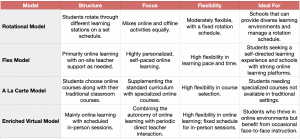4 Core Types of Blended Learning: A Comprehensive Guide

Blended learning combines traditional classroom experiences with digital media and online learning. This fusion creates a hybrid teaching model that uses the strengths of both physical and virtual learning environments. Its adaptability makes it a crucial element in modern education, catering to various learning styles and needs.
In today’s fast-evolving educational landscape, blended learning stands out for its ability to personalize learning and improve flexibility. It creates an engaging, student-centered approach, crucial for keeping pace with technological advancements and changing educational demands.
This article dives into the four primary types of blended learning: the rotational model, the flexible model, the a la carte model, and the enriched virtual model. Each type presents unique strategies and benefits, offering ways to improve learning.
Blended Learning 101
Blended learning is a mix-and-match approach in education. It combines the traditional, face-to-face classroom methods with online learning activities. This means students get the best of both worlds: real-time interaction with teachers and classmates, plus the flexibility and resource-rich environment of online learning.
There are tons of benefits of blended learning. It’sIt’s flexible, allowing students to learn at their own pace and time, which keeps everyone engaged. It also supports diverse learning styles, with materials accessible in various formats. Plus, it encourages self-directed learning, giving students control over their educational journey.
The Rotational Model
The Rotational Model in blended learning is a structured approach where students rotate between different learning modes, including online modules and traditional classroom interactions. This model is characterized by its flexibility, allowing students to engage in various educational activities in a controlled, rotating manner. It effectively blends independent online learning with teacher-guided instruction, catering to diverse learning styles and needs.
For effective implementation of the Rotational Model, educators should ensure a balanced mix of activities that align with their curriculum goals. It’sIt’s important to design each segment – online and offline – to complement each other, ensuring a cohesive learning experience. One of the main challenges is maintaining a smooth transition between activities. Teachers can overcome this by preparing clear schedules and instructions and using technology that efficiently facilitates switching learning modes. Regular monitoring and feedback are crucial to assessing student progress and adjusting the rotation plan.
The Flex Model
The Flex Model in blended learning stands out for its focus on online learning as the primary mode of instruction, complemented by teacher support as needed. This model allows students to navigate their learning paths mainly through online activities while teachers provide on-site support and intervention. Its focus on self-directed learning is unique, with students taking more control over their pace and learning style. Although less structured than traditional classroom settings, the in-person support is tailored to individual student needs, making it a highly personalized approach.
To implement the Flex Model effectively, educators should focus on providing an intuitive, engaging, robust online learning platform. The key is to ensure that the online content is comprehensive and aligns with learning objectives. Teachers play a critical role as facilitators, guiding students through their learning journey, offering support, and intervening when necessary. Therefore, professional development in managing online learning environments and personalized instruction is essential for this learning model to be successful.
A La Carte Model
The A La Carte blended learning model allows students to tailor their education by choosing online courses alongside traditional classroom offerings. This model stands out because it offers flexibility and customization in learning. Students can select online courses that might not be available in their school, catering to diverse interests and academic needs. It’sIt’s particularly suitable in environments where students want to supplement their standard curriculum with more specialized or advanced courses.
Implementing the A La Carte Model comes with its own set of challenges and opportunities. A significant hurdle is ensuring that the online courses integrate well with the existing curriculum and keep students manageable. Providing adequate support for students navigating online learning for the first time is also crucial. While it’sit’s not without drawbacks, this model opens doors to a broader range of subjects and expertise, potentially enhancing student engagement and motivation. Schools can maximize the benefits of the A La Carte Model by carefully selecting high-quality online courses and providing guidance to students in making choices that align with their academic goals and interests.
Enriched Virtual Model
The Enriched Virtual Model is a type of blended learning that primarily occurs online but with scheduled face-to-face interactions as a key component. This model is ideal for providing the flexibility of online learning while still maintaining the personal touch of in-class instruction. It allows students significant autonomy in their education, as they can access and engage with the course material online at their own pace and convenience. The occasional in-person sessions are used for more in-depth discussions, hands-on activities, or individual support, improving the learning experience.
Educators should select the right user-friendly digital tools and platforms supporting various learning styles to implement the Enriched Virtual Model successfully. To keep students motivated, it’sit’s essential to ensure that the online content is engaging and interactive. Balancing the online and face-to-face components is crucial; the in-person meetings should complement online learning, addressing topics that require more direct instruction or collaboration. Regular communication with students is vital to check their progress and adjust the blend of online and in-person activities.
Comparing the Blended Learning Types
The table below compares the Rotational, Flex, A La Carte, and Enriched Virtual Models in terms of their structure, focus, flexibility, and ideal learning environments.
Utilizing LMS to Implement Blended Learning
A LMS is a game-changer for blended learning. It’sIt’s like a digital classroom that supports both online and face-to-face learning. With an LMS, teachers can easily share resources, assignments, and feedback all in one place. Students can access lessons, participate in discussions, and track their progress anytime. This system makes managing course content easier for teachers and enriches the learning experience for students, ensuring a smooth blend of traditional and digital education methods.
Book a demo to find out how Webanywhere can help you build your custom LMS.
Is Blended Learning Right for Your Learners?
Blended learning offers various educational approaches with its diverse models like Rotational, Flex, A La Carte, and Enriched Virtual. It caters to different learning styles, combining the traditional classroom structure with the flexibility of online learning. This blend creates an environment where students can thrive at their own pace and style.
If you’re considering a shift in your educational approach, blended learning is worth embracing. It’s a forward-thinking strategy that aligns with the evolving digital world, preparing learners for tests and life in a tech-centric society.

